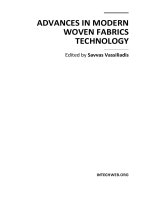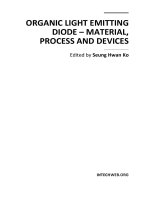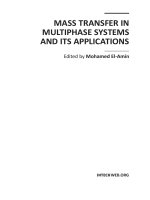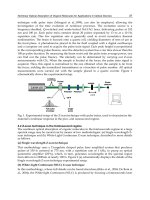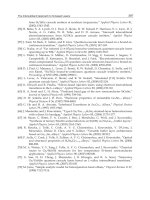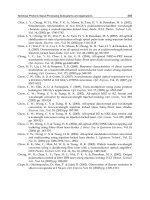Advances in optical and photonic devices Part 1 pot
Bạn đang xem bản rút gọn của tài liệu. Xem và tải ngay bản đầy đủ của tài liệu tại đây (1.12 MB, 20 trang )
Advances in Optical
and Photonic Devices
Advances in Optical
and Photonic Devices
Edited by
Ki Young Kim
Intech
IV
Published by Intech
Intech
Olajnica 19/2, 32000 Vukovar, Croatia
Abstracting and non-profit use of the material is permitted with credit to the source. Statements and
opinions expressed in the chapters are these of the individual contributors and not necessarily those of
the editors or publisher. No responsibility is accepted for the accuracy of information contained in the
published articles. Publisher assumes no responsibility liability for any damage or injury to persons or
property arising out of the use of any materials, instructions, methods or ideas contained inside. After
this work has been published by the Intech, authors have the right to republish it, in whole or part, in
any publication of which they are an author or editor, and the make other personal use of the work.
© 2010 Intech
Free online edition of this book you can find under www.sciyo.com
Additional copies can be obtained from:
First published January 2010
Printed in India
Technical Editor: Teodora Smiljanic
Advances in Optical and Photonic Devices, Edited by Ki Young Kim
p. cm.
ISBN 978-953-7619-76-3
Preface
The title of this book, Advances in Optical and Photonic Devices, encompasses a broad
range of theory and applications which are of interest for diverse classes of optical and
photonic devices. Unquestionably, recent successful achievements in modern optical
communications and multifunctional systems have been accomplished based on composing
“building blocks” of a variety of optical and photonic devices. Thus, the grasp of current
trends and needs in device technology would be useful for further development of such a
range of relative applications.
The book is going to be a collection of the contemporary researches and developments
of various devices and structures in the area of optics and photonics. It is composed of 17
excellent chapters covering fundamental theory, physical operation mechanisms, fabrication
and measurement techniques, application examples. Besides, it contains comprehensive
reviews of recent trends and advancements in the field. First six chapters are especially
focused on diverse aspects of recent developments of lasers and related technologies, while
the later chapters deal with various optical and photonic devices including waveguides,
filters, oscillators, isolators, photodiodes, photomultipliers, microcavities, and so on.
Although the book is a collected edition of specific technological issues, I strongly believe
that the readers can obtain generous and overall ideas and knowledge of the state-of-the-art
technologies in optical and photonic devices.
Lastly, special words of thanks should go to all the scientists and engineers who have
devoted a great deal of time to writing excellent chapters in this book.
January 2010
Editor
Ki Young Kim
Department of Physics
National Cheng Kung University
Tainan, Taiwan
E-mail:
Contents
Preface V
Lasers
1. Broadband Emission in Quantum-Dash Semiconductor Laser 001
Chee L. Tan, Hery S. Djie and Boon S. Ooi
2. Photonic Quantum Ring Laser of Whispering Cave Mode 021
O’Dae Kwon, M. H. Sheen and Y. C. Kim
3. A Tunable Semiconductor Lased Based
on Etched Slots Suitable for Monolithic Integration
039
D. C. Byrne, W. H. Guo, Q. Lu and J. F. Donegan
4. Monolithic Integration of Semiconductor Waveguide Optical Isolators
with Distributed Feedback Laser Diodes
059
Hiromasa Shimizu
5. Optical Injection-Locking of VCSELs 067
Ahmad Hayat, Alexandre Bacou, Angélique Rissons and Jean-Claude Mollier
6. Tunable, Narrow Linewidth, High Repetition Frequency Ce:LiCAF
Lasers Pumped by the Fourth Harmonic of a Diode-Pumped
Nd:YLF Laser for Ozone DIAL Measurements
101
Viktor A. Fromzel, Coorg R. Prasad, Karina B. Petrosyan, Yishinn Liaw,
Mikhail A. Yakshin, Wenhui Shi, and Russell DeYoung
Optical and Photonic Devices
7. Single Mode Operation of 1.5-μm Waveguide Optical Isolators
Based on the Nonreciprocal-loss Phenomenon
117
T. Amemiya and Y. Nakano
8. GaAs/AlOx Nonlinear Waveguides for Infrared Tunable Generation 137
E. Guillotel, M. Ravaro, F. Ghiglieno, M. Savanier,
I. Favero, S. Ducci, and G. Leo
VIII
9. Waveguide Photodiode (WGPD) with a Thin Absorption Layer 161
Jeong-Woo Park
10. Resonant Tunnelling Optoelectronic Circuits 173
José Figueiredo, Bruno Romeira, Thomas Slight and Charles Ironside
11. Integrated-Optic Circuits for Recognition of Photonic Routing Labels 207
Nobuo Goto, Hitoshi Hiura, Yoshihiro Makimoto and Shin-ichiro Yanagiya
12. Chip-Scale Programmable Photonic Filters 223
Duncan L. MacFarlane
13. Quantum Dot Photonic Devices and Their Material Fabrications 231
Naokatsu Yamamoto, and Hideyuki Sotobayashi
14. Silicon Photomultiplier - New Era of Photon Detection 249
Valeri Saveliev
15. Optical Mode Properties of 2-D Deformed Microcavities 273
Soo-Young Lee
16. Practical Continuous-Wave Intracavity Optical Parametric Oscillators 293
Dr David J M Stothard
17. Ultra-Sensitive Optical Atomic Magnetometers and Their Applications
329
Igor Savukov
Lasers
1
Broadband Emission in Quantum-Dash
Semiconductor Laser
Chee L. Tan
1
, Hery S. Djie
1
and Boon S. Ooi
1,2
1
Lehigh University,
2
King Abdullah University of Science & Technology,
1
United States
2
Saudi Arabia
1. Introduction
A new type of semiconductor laser is studied, in which injected carriers in the active region
are quantum mechanically confined in localized finite self-assembled wire-like quantum-
dash (Qdash) structures that are varied in sizes and compositions. Effects of such carrier
distribution and quasi three-dimensional density of states contribute to a quasi-
supercontinuum interband lasing characteristics, which is a new laser design platform as
compared to continuous broad emission spectrum generated by nonlinear media pumped
with ultrashort laser pulse. The wavelength profile of quasi-supercontinuum emission is
tunable at near-infrared wavelength spanning across several optical communication bands
at around ~1500 nm in addition to the ability of operating condition at room temperature as
opposed to that previously obtained only at operating temperature below 100 K. In this
chapter, a thorough analysis of the Qdash material system, device physics and the
establishment of ultrabroad stimulated emission behavior will be presented and discussed.
2. Background
The generation of white light by laser radiation was first reported by Alfano and Shapiro
(Alfano & Shapiro, 1970) who observed a spectral broadening of a picosecond second-
harmonic output of a neodymium garnet laser (400-700 nm) with an energy of about 5 mJ in
the bulk of borosilicate glass. Experiments performed with these bulk samples were then
followed by studies on waveguide white-light generation in air-silica microstructure optical
fibers to date (Ranka, 2000). The generation of the artificial white light is mainly due to the
effective nonlinear-optical transformations of ultrashort laser pulses. Owing to its broad and
continuous output spectrum, such radiation is called supercontinuum. Supercontinuum
generation is an interesting physical phenomenon and the relevant technology is gaining in
practical implications – it offers novel solutions for optical communications and control of
ultrashort laser pulses (Nisoli et al., 1996), helps to achieve an unprecedented precision in
optical metrology (Lin & Stolen, 1976), serves to probe the atmosphere of the Earth
(Zheltikov, 2003), and suggests new strategies for the creation of compact multiplex light
sources (Morioka et al., 1993) for nonlinear spectroscopy, microscopy, and laser
biomedicine.
Advances in Optical and Photonic Devices
2
The first mid-infrared broadband semiconductor laser was demonstrated in an intersubband
structure by adopting a quantum cascade configuration (Gmachl et al., 2002). Laser action
with a Fabry-Perot spectrum covering all wavelengths from 6 to 8 μm simultaneously is
demonstrated with a number of dissimilar intersubband optical transitions. Recently,
similar unique spectral properties in the form of quasi-supercontinuum lasing
characteristics have been demonstrated on semiconductor quantum-dot (Qdot) and Qdash
platforms in different near-infrared wavelength regime without the need of ultrashort pulse
laser excitation or the engineering of the intersubband transition level. (
a
Djie et al., 2007;
Kovsh et al., 2007 ;
b
Djie et al., 2007; Tan et al., 2008). Most important, this unique feature of
quasi-supercontinuum emission occurs at high temperature, i.e. room temperature in
addition to identical operating conditions of a conventional semiconductor lasers. Owing to
its broad and continuous spectrum emitted via only a single semiconductor laser diode,
such device is called broadband laser. The broadband laser technology utilizes largely
inhomogeneous quantum nanostructures active medium such as quantum-dot (Qdot)
structures for wavelength emission in ~1200 nm (
a
Djie et al., 2007, Kovsh et al., 2007); and
Qdash medium for emission in center wavelength of ~ 1600 nm (
b
Djie et al., 2007; Ooi et al.,
2008). Bandgap tuning with emission width widening is possible and can be realized in
Qdash materials via postgrowth lattice interdiffusion technique (Tan et al., 2008; Tan et al.
2009). Furthermore, interband optical transition in quantum confined heterostructures will
contribute to a highly efficient broadband laser action as compared to other emitter
technologies.
A brief review of current state-of-art of Qdot/Qdash technology is necessary to comprehend
the origin and progress of semiconductor broadband laser. To date, conventional self-
assembled Qdot/Qdash semiconductor nanostructures have attracted considerable interest
in the fabrication of semiconductor lasers and optical amplifiers due to the unprecedented
potential offered by three-dimensional energy levels quantification that lead to vastly
improved optoelectronic characteristics as compared to conventional quantum-well (QW)
structures and bulk materials (Bimberg et al., 1997; Wang et al., 2001; Ooi et al., 2008). Apart
from its predominant applications in optoelectronics industry, self assembled Qdot/Qdash
demonstrate a number of unique features as compared to QW materials. In particular, self-
assembled Qdot lasers have been shown to emit unique lasing spectral characteristics,
where the laser emission spectra are broadened with modulated non-lasing spectral regions
and the number of lasing modes increases above threshold (Harris et al., 1998). Furthermore,
early experiments showed an extraordinary wideband lasing coverage of 50 nm, in the
absence of modulated non-lasing spectral regions, but only at a cryogenic temperature (60
K) from Qdot gain medium (Shoji et al., 1997; Jiang & Singh, 1999). These phenomena have
been attributed to the carrier localization in noninteracting or spatially isolated dot
ensembles and nonequilibrium carrier distribution among highly inhomogeneous Qdots
(Harris et al., 1998; Jiang & Singh, 1999). The most recent study reveals that a low-ripple (<3
dB) non-modulated broad interband lasing coverage of ~40-75 nm from GaAs-based Qdot
lasers can be achieved at room temperature with center wavelength of ~1160-1240 nm by
employing a highly inhomogeneous InGaAs Qdot structures (Djie et al., 2007) and chirp
InGaAs Qdot structures (Kovsh et al., 2007). These novel semiconductor light emitters are
particularly attractive for many practical imaging and sensor applications due to their
compactness and relatively low energy requirement in comparison to other state-of-art
broad spectrum light sources.
Broadband Emission in Quantum-Dash Semiconductor Laser
3
The effort of achieving this interesting broadband lasing action in a longer wavelength
region (1.5-1.6 μm) will thus be critical for broader applications relevant to the important
low-loss transmission window of fiber optic system such as multichannel optical
communication system, fiber-based optical coherent tomography, interferometric fiber optic
gyroscopes, optical measurement systems, etc. Intensive research in the advanced growth of
InP-based self-assembled Qdash had enabled the realization of high quality lasers and
optical amplifiers that potentially cover the wavelength operation on both 1.31 μm and 1.55
μm of optical communication bands (Wang et al., 2001). Qdash assembly is essentially
comprised of isotropic Qdots and finite quantum-wires (Qwires), whose cross section is
similar to that of a typical Qdot, 3-4 nm (height) × 10-20 nm (base), while its length is varied
from tens to hundreds of nanometers, as pictured by scanning electron microscopy (Dery et
al., 2004) and atomic force microscopy (Popescu & Malloy, 2006). Due to quasi-three-
dimensional carrier confinement and intrinsic properties, Qdash enable several interesting
laser diode characteristics such as improved temperature insensitivity, optical feedback
resistance, wide spectral tunability, and broad stimulated emission (Sek et al., 2007; Lelarge
et al. 2007;
b
Djie et al., 2007). In addition, the gain properties of a Qdash amplifier bearing
the distinct fingerprint of a quantum-wire-like density of states (Dery et al., 2004) while gain
recovery characteristics and recovery time constants resembling Qdot characteristics (van
der Poel et al., 2006). More so, it has been proposed that the role of optical gain broadening
(Tan et al., 2007) that results in broadband emission from Qdot lasers is also inherent in
Qdash lasers. These unique features will help to overcome the challenges in the nanoscaled
epitaxial engineering of highly inhomogeneous Qdot for broadband laser applications.
All the interesting features of broad interband lasing actions from self-organized, spatially-
isolated semiconductor nanostructure technology can be widely applied in optical
telecommunications, various optical sensors detecting chemical agents, atmospheric or
planetary gases, high-precision optical metrology and spectroscopy, and biomedical
imaging (Ooi et al., 2008). In addition, it is natural to expect that narrow pulses can be
generated by locking the phases of modes in this quasi-supercontinuum interband laser
spectrum under mode-locked operation (Xing & Avrutin, 2005) due to the fast carrier
dynamics and the broad optical gain bandwidth (Lelarge et al., 2007). Furthermore, the high
power emission capability of ~1 W per device from these ultrabroadband Qdash lasers at
room temperature (Tan et al., 2008) can be potentially employed as a high efficiency
resonant pumping source (Garbuzov et al., 2005) for eye-safe Er-doped amplifiers and solid-
state lasers.
In this chapter, we will present the generation of ultrabroad stimulated emission at room
temperature operating condition in the InP-based broadband laser with wide wavelength
coverage. For the first time, the InP-based unique dash quantum confined heterostructure
properties is exploited to generate a broad lasing spectrum, following the prior success of
short wavelength GaAs-based Qdot broadband laser. The fabricated Qdash laser diode
emits at ~1.64 μm center wavelength with wide wavelength coverage of 76 nm. Unlike
conventional diode lasers, the rule changing broadband lasing is obtained from the quasi-
continuous interband transition by the inhomogeneous Qdash ensembles.
To further enhance the broad spectrum emission and fine tune the lasing wavelength
coverage, we further engineer the bandgap energy of Qdash material with postgrowth
lattice intermixing process utilizing impurity-free vacancy induced disordering (IFVD)
technique. We successfully demonstrated a 100 nm wavelength blue-shifted Qdash lasers
Advances in Optical and Photonic Devices
4
exhibiting a room-temperature broad lasing spectral coverage of ~85 nm at a center
wavelength of ~1.55 μm with enhanced total emission power of ~1 W from a single as-
cleaved broad area laser structure (50 x 500 μm
2
). The peculiar broad lasing spectra from
fabricated diodes with different cavity lengths related to the effect of nonequilibrium carrier
distribution in these highly inhomogeneous dashes will also be discussed.
3. Experiments and theoretical modelling
3.1 Materials and laser structure
Fig. 1. (a) The plane-view AFM image (area of 0.5×0.5 µm
2
; height contrast of 8 nm) and the
cross-sectional TEM images across [110] and [
11 0
] directions. (b) The illustration of carrier
confinement in Qdash structure (top). Only the first two energy levels (E
1
and E
2
) are shown
for clarity. The height distribution profile of dash islands from AFM image (middle), that
results in the density of states (DOS) spreading over the energy and forms the quasi-
continuous interband transition (bottom).
The InAs/InAlGaAs Qdash material used in this study was grown by molecular beam
epitaxy (MBE) on (1 0 0) oriented InP substrate. The laser is a p-i-n structure with active
region consisting of four-sheet of InAs Qdashes, and each Qdash layer is embedded in an
asymmetric InAlGaAs QW. The QWs are then sandwiched between two sets of SCHs. The
Qdash-in-well structure consists of a 1.3 nm thick compressively strained In
0.64
Ga
0.16
Al
0.2
As
layer, a five-monolayer (ML) thick InAs dash layer, and a 6.3 nm thick compressively
strained In
0.64
Ga
0.16
Al
0.2
As layer. Each dash-in-well stack is separated by a 30 nm thick
tensile strained layer of In
0.50
Ga
0.32
Al
0.18
As that acts as the strain compensating barrier. The
lower cladding consists of a 200 nm thick In
0.52
Al
0.48
As layer doped with Si at 1 × 10
18
cm
-3
,
which is lattice matched to the InP substrate. The upper cladding and contact layers are 1700
nm thick In
0.52
Al
0.48
As and 150 nm thick In
0.53
Ga
0.47
As, respectively. Both layers are doped
with Be at 2 × 10
18
cm
-3
(Djie et al., 2006; Wang et al., 2006). Fig. 1(a) shows the plane-view
atomic force microscopy (AFM) of the surface Qdash and the cross-sectional transmission
electron microscopy (TEM) images of the laser structure. The Qdash structure comprises
three-dimensional elongated nanostructure preferentially aligned along [
11 0
] direction
with an average height of 3.2 nm, an average width of 18 nm, and the base or length varied
Broadband Emission in Quantum-Dash Semiconductor Laser
5
from 20 to 75 nm. The individual Qdash provides strong carrier confinement along y- and z-
directions and weaker confinement along the x-direction [Fig. 1(b-top)]. The AFM image
reveals the nanostructure networks composed of dot-like and finite wire-like quantum
confined structures with a bimodal height distribution profile [Fig. 1(b-middle)]. The
isotropic, dot-like structure with a comparable width over the length have a relatively larger
height than the wire-like structure suggesting that the elongated islands are formed by the
coalescence of two or more dot-like islands. Considering the large dispersion in shape, size
and composition, the inhomogeneous Qdash gives a wide energy spreading in the confining
potentials. This effect leads to the broadened optical gain characteristics [Fig. 1(b-bottom)]
suitable for the wideband optical devices such as superluminescent diodes (SLD) (Djie et al.,
2006).
For the purpose of further enhancement of the broad spectrum emission and fine tune of the
lasing wavelength coverage, we performed the dielectric cap annealing technique to induce
selective intermixing using 475 nm thick SiO
2
layer as an vacancy source deposited using
plasma enhanced chemical vapor deposition system. During the annealing, the SiO
2
cap will
enhance the preferential atomic outdiffusion hence enhancing the group-III atomic
interdiffusion in the Qdash active region and resulting in the effective bandgap modification
of Qdash material (Tan et al., 2008; Wang et al., 2006). The dielectric cap also serves to
protect the surface quality during annealing from the thermal induced decomposition.
Following the dielectric cap removal, state-filling PL spectroscopy using a 980 nm diode
laser as an excitation source was performed at 77 K to assess the bandgap modification from
the interdiffusion effect on the laser structure. The IFVD process is performed by annealing
the SiO
2
capped sample in nitrogen ambient for one minute in a rapid thermal processor
(RTP). Fig. 2 gives the summary of PL peak shift and the linewidth as the annealing
temperature increases from 600ºC to 850ºC. At the temperature of 750ºC, the PL peak shifts
towards a shorter wavelength emission while the linewidth is the broadest. Further increase
in annealing temperature initiates more intermixing, and therefore improves the uniformity
in shape, size and composition of Qdash leading to reduction in PL linewidth. The result
points out the linewidth broadening at intermediate stage of intermixing due to non-
uniform interdiffusion, which will be further selected to broaden the Qdash laser emission.
Fig. 2. The evolution of PL peak shift and linewidth measured at 77 K with varying
annealing temperature of rapid thermal processor from SiO
2
capped Qdash samples. The
inset depicts the normalized PL spectra for selected temperatures clearly showing the
broadening of PL linewidth at the intermediate degree of intermixing.
Advances in Optical and Photonic Devices
6
Broad area lasers with 50 μm wide oxide stripes with no facet coating were then fabricated
from both the as-grown and intermixed Qdash samples (under annealing temperature of
750 ºC ) with SiO
2
capped layer. In order to maximize the gain (Ukhanov et al., 2002), the
optical cavity of the laser is aligned along the [011] orientation and is perpendicular to the
dash direction. Current injection was performed to the non-facet-coated Qdash lasers under
pulsed operation at 0.2% duty cycle with a 2 μs pulse width.
3.2 Simulation model of group-III interdiffusion
The understanding of diffusion processes is important to the interpretation of interdiffusion
induced compositional change and the band structure modification related to the
experimental works and selected postgrowth operating conditions presented in the previous
sections. In IFVD process, majority vacancies are injected vertically from the dielectric cap
during thermal treatment and therefore the interdiffusion will occur more effectively in the
transverse direction that corresponds to the dash height (Tan et al., 2008; Wei & Chan, 2005).
This diffusion effect becomes more pronounced at very thin Qdash layer when the dash
height to base ratio is of ~ 0.1 or less (Wang et al., 2006). At intermediate stage of
intermixing, the partial intermixing might occur, which the thick dash family will
experience a larger degree of wavelength blue-shift due to the larger concentration (Crank,
1975) of active medium composition and hence its interdiffusion length is larger than the
thin dash family. The solution of the diffusion problem (Crank, 1975) in the Qdash can be
estimated by an equivalent one dimensional quantum-confined model (transverse direction
of vacancies interdiffusion) by assuming a substance of concentration C
0
, confined in a
region of n repeating well and barrier of width w and b, respectively, centered at zero
(Gontijo et al., 1994) that is given by
0
1
(1)( ) [ (1)]
[2 [ ( ) ( )]
22 2
k
n
n
DD
Cxnwbxnwnb
Cerf erf
LL
=
−− + − +−
=− +
∑
(1)
Fig. 3. The blueshift of normalized transition wavelength when diffusion length increases in
one-dimensional quantum confined structure with different well widths (L
z
). The inset
shows the corresponding change of the transition wavelength shift with normalized
diffusion length to QW/Qdash.
Broadband Emission in Quantum-Dash Semiconductor Laser
7
The origin of the x coordinate is at the left barrier of the first well. The one-dimensional
quantum-confined structure of four repeating wells and barriers with arbitrary width are
used in the simulation model to calculate the confined ground state energy level. The chosen
material system is not critical because it serves only as a reference for the change of
transition energy states with diffusion length (L
d
) and well thickness. The quantum confined
energy levels can be obtained by solving the one-dimensional time-independent
Schrodinger equation and the results are shown in Fig. 3 and its inset. Different well widths
(3, 4, 5 and 8 nm) with varied L
d
are used in the calculation model to represent the different
dash heights in the real Qdash assembly. As L
d
increases, the wavelength shift to shorter
wavelength due to group-III interdiffusion. The blue-shift rate is faster at same L
d
for thin
nanostructure than the thick nanostructure, as stated in Fig. 3. At intermediate stage of
intermixing, the disparity in wavelength blueshift is notable. As intermixing proceeds
further, the variation rate in wavelength blueshift becomes less until the nanostructure
becomes fully intermixed and the wavelength blueshift converges. Noting a high dispersion
in Qdash structure used in the experiments [16], widened gain characteristics can be
practically achieved by selecting suitable degree of intermixing to the Qdash structure.
Thereafter, the broadened linewidth can be attributed to the different intermixing results
from inhomogeneous nanostructure in Qdash assembly at a medium degree of intermixing.
Experimentally, this can be obtained by a given dielectric film properties heat-treated under
the suitable annealing temperature and/or duration. Furthermore, variation in transition
energy state is more sensitive to the L
d
as compared to the well width. The thick dash family
that tends to induce larger L
d
contribute to larger blueshift of peak emission is as shown in
the inset of Fig. 3. Hence, there is a smaller peak emission blueshift in the intermixed
samples as compared to the as-grown samples under high excitation.
4. Results and discussion
4.1 Optical properties of Qdash – As-Grown and intermixed materials
State-filling photoluminescence (PL) spectroscopy of as-grown Qdash samples were
performed at 77 K by varying optical excitation density. As comparison, InAs Qdot
embedded in InP matrix was grown and also characterized. The ground state PL peak
emission is longer in Qdot as the InP matrix has a larger bandgap energy than InAlGaAs
confining layers in the Qdash. Qdot structure shows well-resolved quantized states (E
0
to
E
4
) with a large energy separation between E
0
and E
1
(ΔE = 34 meV) compared to Qdash
characteristics (up to E
4
with ΔE = 30 meV). At similar excitation density, more states are
excited in Qdot than Qdashes as a manifestation of the enhanced DOS in Qdot subbands
[Fig. 4]. At high excitation (1500 W/cm
2
), a large number of minima in Qdash spectra are
populated, resulting a broad emission line while in Qdot spectra, the individual minima is
more apparent. These properties corroborate the quasi-continuous interband transition
characteristics in Qdash over a wide wavelength range. The discrepancies between Qdot
and Qdash are due to the shape of DOS [Fig. 1(b)]. Qdash with size and composition
fluctuations have overlapping states with nearly identical transition energies in the high-
energy portion that contributes to the gain broadening and thus produces less resolved
confined state recombination in PL spectra. However, this is not the case in the Qdot
assembly due to its delta function DOS leading to the atomic-line luminescence spectra.
Advances in Optical and Photonic Devices
8
Fig. 4. (a) PL spectra at 77 K with varying optical pumping level taken from InAs Qdots
within InP matrix (above) and InAs Qdashes within InAlGaAs matrix (below). The confined
energy subbands are indicated with the arrow, after the deconvolution with the multi-
Gaussian spectra. (b) EL spectra at RT showing the spontaneous emission (top) at J=0.8×J
th
from a 300 µm device and the lasing emission spectra (bottom) from E
0
, E
1
and E
2
states.
These individual lasing lines are obtained from laser with cavity length L of 1000, 300, and
150 µm, respectively, at 1.1×J
th
.
Broad area as-grown Qdash lasers with 50 µm wide oxide stripes without facet coating were
fabricated and characterized. Fig. 4(b) shows the electroluminescence (EL) spectrum of the
Qdash samples revealing fine structures of amplified spontaneous emission from different
energy subbands in correlation to different lasing peaks. Up to three distinct laser emissions
(1.65, 1.62, and 1.59 µm) from E
0
, E
1
and E
2
energy transitions were obtained at J = 1.1×J
th
from lasers with cavities L of 1000, 300, and 150 µm, respectively. The distinct lasing
wavelength peak is attributed to the finite modal gain of each quantized state in Qdash
assembly.
Carriers localized in different dots/dashes, resulting in a system without a global Fermi
function and exhibiting an inhomogeneously broadened gain spectrum, have shown an
interesting phenomena of lasing spectra (Harris et al., 1998;
a
Djie et al., 2007; Tan et al., 2007;
Matthews et al., 2002). This unique feature of dot/dash can be well studied after postgrowth
interdiffusion technique, from the evolution of state-filling spectroscopy from intermixed
Qdash structures at 77 K, as shown in Fig. 5 and its inset. At low excitation below 3 W/cm
2
,
the ground state emissions of 1.57 μm and 1.50 μm are dominant in the as-grown and the
intermixed samples, respectively. The PL spectra are gradually broadened in both samples
with increasing optical excitation densities. An increase in the excitation power density
leads to the filling of lower-energy states, allowing recombination from higher energy levels
of Qdash structure. Under the same excitation density, the PL linewidth of intermixed
sample is wider than the as-grown sample. At the power excitation density of 1500 W/cm
2
,
the PL linewidth increases by 11 nm (from 94 nm to 111 nm) after intermixing process. The
phenomenon of carrier localization in Qdash becomes more evident when the intermixed
Broadband Emission in Quantum-Dash Semiconductor Laser
9
sample shows a larger variation of full-width-half-maximum (ΔFWHM up to 47 nm) than
the as-grown sample (ΔFWHM up to 18 nm) under various power excitation densities
relative to the FWHM obtained at the optical excitation of 3 W/cm
2
, as shown in the inset of
Fig. 3.
Fig. 5. The PL spectra of both as-grown and intermixed samples, with varying optical
pumping levels, show global blueshift after intermixing. The inset shows the corresponding
changes of FWHM and PL peak wavelength as compared to those obtained under optical
excitation of 3 W/cm
2
.
These enormously large broadening of the PL spectra from both the as-grown and
intermixed samples is attributed to the contribution of multiple transition states (
a
Djie et al.,
2007) or large inhomogeneous broadening of the non-interacting Qdash ensembles (Tan et
al., 2007; Van der Poel et al., 2006). This observation is also clearly different from that of both
conventional QW (Ooi et al., 1997) and Qdot structures (Wang et al., 2006). The IFVD
technique is generally well-known to improve the size homogeneity of a highly
inhomogeneous semiconductor nanostructure system and thus will contribute to smaller
variation in energy transition after intermixing. For instance, at the power excitation density
of 1500 W/cm
2
, the PL linewidth decreases by 6 nm (from 94 nm to 88 nm) after the IFVD
process is performed by annealing the SiO
2
capped sample at 750ºC for two minutes (Djie et
al., 2008). However, the opposite observations in the Qdash, i.e. larger PL linewidth after
intermediate intermixing, suggests the presence of different interdiffusion rates at a given
intermixing degree in the Qdash nanostructures as a consequence of wide variation in
surface to volume ratio in Qdash ensembles. The presence of more non-interacting Qdash
with wider distribution of energy levels will contribute to radiative recombination emission
over larger wavelength coverage and thus a larger FWHM in PL spectra. In other words,
carrier localization is more prominent in an isolated Qdash, which affects the optical
properties of these material systems. Nevertheless, both intermixed and as-grown Qdash
samples showing saturation of ΔFWHM at excitation power over 400 W/cm
2
indicates that
large degeneracy levels in highly confined energy states of Qdash is still preserved as can be
seen in Qdot nanostructures (Hadass et al., 2004).
The nearly symmetric Qdash PL spectra in Fig. 5 are broadened with increasing optical
excitation densities. Furthermore, an increase in integrated PL intensity after intermixing
Advances in Optical and Photonic Devices
10
occurs. All these observations are contrary to the conventional quantum-confined
nanostructures. These can be attributed to the continuous PL wavelength blue-shift
observed in both as-grown and intermixed samples, as shown in Fig. 5, with increasing
optical excitation densities. The continuous blue-shift of the PL peak wavelength up to 88
nm in the as-grown sample and 61 nm in the intermixed sample at the optical excitation
density of 1500 W/cm
2
, relative to those obtained at the excitation of 3 W/cm
2
, are shown in
the inset of Fig. 5. The effect of band-filling is insufficient to explain the large degree of blue-
shift observed from sample excited under high density excitation. Hence, it is reasonably
ascribed this to the postulation of continuum states (Van der Poel et al., 2006) in the Qdash
nanostructures, although spectral widening at a shorter wavelength is expected in an
inhomogeneous Qdash structure (Hadass et al., 2004). Continuum states serve as an
effective medium for exciton scattering and thus change the dephasing rate (Tan et al., 2007)
at each energy level within the highly inhomogeneous ensembles and the radiative
recombination profile will be different from that of conventional QW. The wide distribution
of energy levels due to the nature of Qdash inhomogeneous (FWHM of 76 nm from PL
measurement of as-grown sample at low excitation of 3 W/cm
2
) will further serve as the
radiative recombination states or “sink” for the scattered excitons from the dense continuum
states. Consequently, quasi-supercontinuum lasing spectra of the diode laser fabricated
from these samples are observed, which will be discussed in the later section. Nevertheless,
smaller blue-shift of PL peak wavelength in the intermixed sample, as depicted in the inset
of Fig. 5, indicates that IFVD enhances the Qdash inhomogeneity more so in larger sizes of
Qdashes, which emit at longer wavelengths. Assuming a uniform injection of group-III
vacancies from the surface during the IFVD process, the interdiffusion in the vertical
direction will affect the dash height more than other directions (Djie et al., 2008; Wei et al.,
2005). At an intermediate stage of intermixing, the thick dash family, where the quantized
energy level located closer to the conduction band minima, will experience a larger degree
of intermixing as the effective height or thickness of the dash decreases, as depicted in the
inset of Fig. 3. In addition, the local effective concentration for the thick dash family is
higher than the thin dashes. Under uniform annealing temperature, the thick Qdash family
that has larger interdiffusion length will yield larger degree of intermixing. As a result,
largest degree of wavelength blue-shift (~65 nm) is observed at low excitation of 3 W/cm
2
(dominant emission from thick dashes) as compared to the smaller wavelength blue-shift
(~38 nm) at high excitation of 1500 W/cm
2
(dominant emission from thin dashes).
4.2 Effect of nonequilibrium carrier distribution from intermixed lasers
Broad area laser characterization of the intermixed samples further provides evidence of a
multi-state emission as shown in Fig. 6. A spectral widening is apparent as the bias increases
(Hadass et al., 2004). The emission spectra show multi-state lasing emission as injection
increases to current density J of 1.5 x J
th
(threshold current density) and above as opposed to
a series of well-defined groups of longitudinal modes (Harris et al., 1998) emission above
threshold in highly inhomogeneous Qdot. This implies the preservation of 3-dimensional
energy confinement of the Qdash in addition to the emission from multiple sizes of Qdash
ensembles as shown in Fig. 7 and Fig. 8 for fabricated lasers with different cavity lengths.
The localized active region of the device can be treated as a large number of Qdot or Qdash,
which can be further treated as a broad distribution of discrete energy levels (Shoji et al.,
1997). This is owed to the inhomogeneous broadening nature of Qdash ensembles and the
